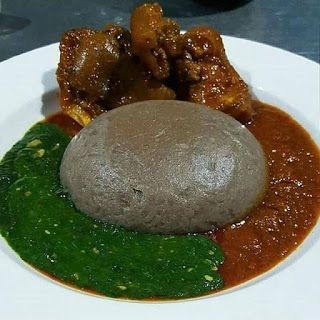Amala
Amala: A Deep Dive into Nigeria’s Traditional Staple
Introduction
Amala, a traditional Nigerian dish, holds a special place in the hearts of many. It is a cherished meal, particularly popular among the Yoruba people of southwestern Nigeria. Made from yam, plantain, or cassava flour, Amala is a simple, starchy dish that is paired with various savory soups, making it a staple food in homes, local restaurants (bukas), and street food stalls. More than just a dish, Amala represents culture, identity, and history, offering a profound connection to the roots of Nigerian cuisine.
This blog will take you through the world of Amala, from its origins and cultural significance to the varieties and recipes. We’ll also explore how it’s being incorporated into modern Nigerian cuisine, and why Amala remains a beloved comfort food for millions of people.
The Origins of Amala
Amala traces its origins to the Yoruba people of southwestern Nigeria, where it has been a staple for centuries. The Yoruba diet historically revolved around starchy foods such as yams, cassava, and grains, all of which are readily available in the region. These starches, when processed and cooked, form the base of many meals, with Amala being one of the most prominent.
Amala was originally made from dried yam flour (known as “elubo”), which was pounded into powder form after being sun-dried. Yam is an essential crop in Nigeria and is a symbol of wealth and sustenance. It grows abundantly in the southwestern part of the country, making it a reliable food source. Over time, cassava and plantain variants of Amala emerged, offering variety to this beloved dish.
Types of Amala
Amala comes in different varieties, each with a distinct flavor and nutritional profile. While all share the same basic preparation method, they differ based on the flour used. The three most common types are:
- Amala Isu (Yam Flour Amala): Amala Isu, made from yam flour (elubo), is the most traditional and widely consumed type of Amala. To make the flour, yams are peeled, cut into small pieces, sun-dried, and then ground into a fine powder. When prepared, Amala Isu has a light brown color, a soft, elastic texture, and a neutral, earthy flavor that pairs well with bold, flavorful soups.
- Amala Lafun (Cassava Flour Amala): Amala Lafun is made from fermented cassava flour. Unlike yam flour, cassava is peeled, grated, fermented, and dried before being ground into flour. The fermentation process gives Amala Lafun a slightly sour taste, which complements spicy or tangy soups. Lafun is white in color and has a slightly different texture from Amala Isu—thicker and sometimes more gelatinous.
- Amala Ogede (Plantain Flour Amala): Amala Ogede is made from plantain flour. Unripe plantains are sliced, dried, and ground into flour, producing a slightly greenish-brown Amala with a mildly sweet flavor. Amala Ogede is considered the healthiest of the three varieties due to its high fiber content and low glycemic index, making it a popular choice among people with diabetes or those seeking a more nutritious alternative to traditional starchy foods.
Cultural Significance of Amala
Amala is not just a dish—it is a symbol of Yoruba identity and cultural pride. In Yoruba society, food plays a vital role in communal gatherings, celebrations, and rites of passage. Amala is often served at weddings, naming ceremonies, funerals, and other important events, where it is enjoyed with an array of rich, flavorful soups such as ewedu, gbegiri, or ogbono.
Among the Yoruba, sharing a meal of Amala and soup is an expression of hospitality, unity, and togetherness. It is also a dish deeply rooted in spirituality and tradition, often served during religious festivals or offered to ancestors during ritual ceremonies. Amala’s significance goes beyond its nutritional value; it embodies the essence of Yoruba communal life and the importance of food as a means of connection.
In modern times, Amala has transcended its Yoruba roots and become popular in other parts of Nigeria, especially in urban centers like Lagos, where restaurants specializing in traditional Nigerian cuisine serve the dish to patrons from diverse ethnic backgrounds.
Traditional Accompaniments: The Perfect Pairing
Amala is usually served with soups that balance its starchy texture and neutral flavor. The most popular soups served with Amala include:
- Ewedu Soup: Ewedu soup, made from jute leaves, is a staple pairing with Amala in Yoruba cuisine. The leaves are blended or pounded into a smooth, viscous soup and cooked with local spices. Ewedu is highly nutritious and is often served with a tomato-based stew or gbegiri soup for a delicious combination of textures and flavors. The sticky consistency of Ewedu makes it perfect for scooping up Amala.
- Gbegiri Soup: Gbegiri is a smooth soup made from black-eyed beans. The beans are cooked until soft, blended into a smooth paste, and seasoned with spices and palm oil. Gbegiri’s thick, creamy consistency makes it a perfect partner for Amala, particularly when combined with Ewedu and a rich stew, creating a famous trio called “Abula.”
- Ogbono Soup: Ogbono soup is made from ground ogbono seeds (wild mango seeds) and has a thick, gelatinous texture. It is often cooked with assorted meats, fish, and vegetables, making it rich and flavorful. The soup’s slippery consistency complements the smoothness of Amala, making it a popular choice for those who prefer hearty, filling meals.
- Efo Riro: Efo Riro is a Nigerian spinach stew made with leafy greens, tomatoes, and assorted meats. It is a versatile and flavorful soup that pairs beautifully with Amala. The spiciness and depth of flavor in Efo Riro contrast perfectly with the mildness of Amala, making it a common accompaniment.
How to Make Amala: A Step-by-Step Guide
Making Amala at home is straightforward, but it requires some practice to get the consistency just right. Below is a simple recipe for preparing Amala Isu (Yam Flour Amala).
Ingredients:
- 2 cups of yam flour (elubo)
- 4-5 cups of water
Instructions:
- Boil Water: Start by bringing 4 cups of water to a rolling boil in a large pot. The water should be enough to completely absorb the yam flour without leaving lumps.
- Add the Yam Flour: Once the water is boiling, gradually pour in the yam flour while stirring vigorously with a wooden spatula (omorogun) to prevent lumps from forming. Continue stirring until the flour is fully absorbed and the mixture begins to thicken.
- Adjust the Consistency: If the mixture is too thick, add a small amount of hot water and stir continuously until you achieve a smooth, stretchy consistency. Amala should be smooth, elastic, and free of lumps.
- Steam: Once the desired consistency is reached, cover the pot and allow the Amala to steam on low heat for a few minutes. This helps to cook the flour thoroughly.
- Serve: Scoop the Amala into a bowl and serve hot with your preferred soup, such as Ewedu, Gbegiri, or Ogbono.
Nutritional Benefits of Amala
Amala offers a range of nutritional benefits, particularly when paired with nutrient-dense soups. Depending on the type of flour used, the nutritional profile of Amala can vary. Here’s a breakdown of the health benefits of the different types of Amala:
- Amala Isu (Yam Flour): Yam flour is rich in complex carbohydrates, which provide long-lasting energy. It also contains dietary fiber, which aids digestion, and is a good source of potassium, manganese, and vitamin C.
- Amala Lafun (Cassava Flour): Cassava flour is gluten-free and is a rich source of carbohydrates, making it a great option for those with gluten intolerance. It also contains important vitamins and minerals, including vitamin C and folate. However, cassava flour should be consumed in moderation as it can be high in calories.
- Amala Ogede (Plantain Flour): Plantain flour is the most nutritious of the three, as it is high in fiber and low in sugar, making it an excellent choice for people with diabetes or those looking to maintain a healthy diet. It also contains a variety of vitamins, including vitamin A, vitamin C, and vitamin B6, as well as essential minerals like magnesium and potassium.
Amala in Modern Nigerian Cuisine
While Amala remains deeply rooted in traditional Nigerian culture, it has also made its way into modern culinary trends. In recent years, Nigerian chefs have begun incorporating Amala into innovative dishes, blending traditional recipes with contemporary techniques and ingredients. This has led to the creation of dishes such as:
- Amala Burger Patties: Chefs have experimented with turning Amala into burger patties, seasoned with local spices and served with gourmet toppings. This fusion of Nigerian and Western cuisine has been well-received in both local and international food scenes.
- Amala Wraps: In urban areas, street food vendors have started offering Amala wraps, where the starchy dough is rolled into flat, pliable wraps and filled with meats, vegetables, and spicy sauces. This modern take on the dish appeals to a younger audience looking for convenient, on-the-go meals.
- Amala Fries: Another modern twist is Amala fries, where the dough is sliced into strips and deep-fried to create crispy, golden fries. These are often served with spicy dipping sauces, making for a delicious snack or side dish.
- Amala in Fine Dining: Nigerian fine dining establishments have also started reimagining traditional dishes like Amala, offering it as part of multi-course tasting menus. In these settings, Amala is often plated with artistic flair, paired with gourmet versions of soups like Efo Riro, and garnished with microgreens or edible flowers.
Conclusion: Amala’s Enduring Legacy
Amala has stood the test of time as one of Nigeria’s most beloved dishes. Its deep cultural significance, coupled with its nutritional value and versatility, makes it a staple food in Nigerian households and restaurants. Whether enjoyed in its traditional form with Ewedu and Gbegiri or reimagined in modern cuisine, Amala continues to be a source of comfort and pride for Nigerians around the world.
As Nigerian food continues to gain global recognition, Amala is set to remain a key player in showcasing the richness and diversity of West African cuisine. Its unique texture, simplicity, and ability to complement a variety of flavors ensure that it will be enjoyed for generations to come.



